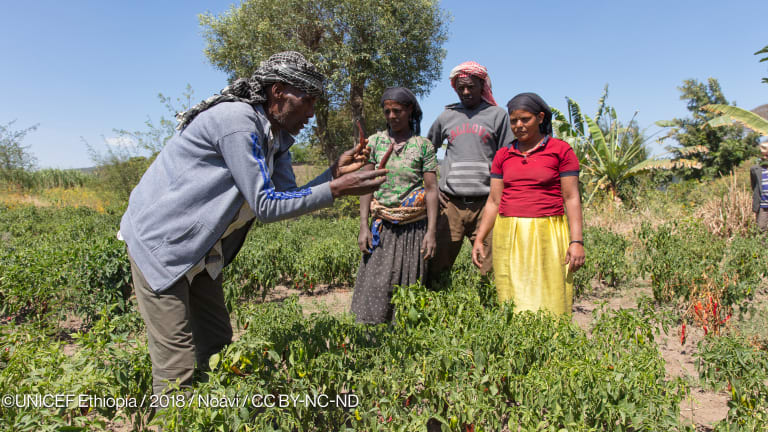
Neither food systems transformation, nor climate and biodiversity action agendas can succeed if work to achieve their goals is not linked, experts tell Devex.
Get the inside track on how agriculture, nutrition, sustainability, and more are intersecting to remake the global food system in this weekly newsletter.
Last week’s United Nations Food Systems Summit was the culmination of over 18 months of work to break down silos between sectors and change the way the world grows, transports, and consumes food.
Three of the summit’s 5 “action track” areas — shift to sustainable consumption patterns; boost nature-positive production; and build resilience to vulnerabilities, shocks, and stress — are directly related to climate and the environment, and participants in the process say governments and donors will not be able to meet the goals of next month’s 26th U.N. Climate Change Conference, if food systems are not central to that event.
Joao Campari, who led UNFSS Action Track 3: Boost nature-positive production, said that going into COP 26, the world must recognize the “triple challenge” humanity faces.
“The challenge ahead is how to feed the population, and how to produce and consume in a sustainable way [so] that we reduce the effects [of] climate change.”
— Maria Helena Semedo, deputy director-general for climate and natural resources, Food and Agriculture Organization“[This is a] plea for everyone to connect the food, climate, and nature agendas because sometimes we tend to forget this. The food system is responsible for about 70% of the biodiversity loss on land and 50% on freshwater. The food system is responsible for … between 29% and 33% of global greenhouse gas emissions,” said Campari, who is also the global leader of the World Wildlife Foundation’s food practice.
“So if we collectively don’t transform the food system, we will lose the battle against nature loss and climate change,” he continued “This is a very serious issue. And I don’t see this being brought forward as a triple challenge as often as we have to.”
The goals for COP 26 — an annual stocktaking of progress on the Paris Agreement, hosted this year by the United Kingdom — include building resilient agriculture and curtailing deforestation, as well as a call to restore nature and habitats for more sustainable farming.
Campari said WWF sees agroecology and regenerative agriculture as central to the restoration of land and water ecosystems. The world must also transform the way in which it rewards farmers and fishers, he said, including by repurposing harmful subsidies and freezing the carbon footprint of food production. A recent Food and Agriculture Organization report found that approximately 87% of global agricultural subsidies are detrimental to people and the planet.
More on food systems:
► Agricultural subsidy reform is needed to meet SDGs, UN report says
► '9 harvests left': Food Systems Summit urges swift action by 2030
► Q&A: IDB says Latin America can lead on sustainable agri-supply chains
Clear commitment from world leaders will be necessary to meet the triple challenge, Campari said, and COP 26 is an opportunity to make real progress. But holding leaders accountable for their commitments at such events is a severe challenge, he added, because actions are difficult to monitor and evaluate after an announcement is made.
“The first thing that we need in terms of accountability is the political message that comes from world leaders. We need bold statements, we need the commitment to ambitious actions to integrate food, nature, and climate goals,” Campari said. “But commitments are not enough.”
Campari said that leaders from the Food Systems Summit process will still work together so that successful connections across disciplines of the food system, including climate and the environment, will continue.
Finding success in using food systems transformation to meet climate goals will require centering smallholder farmers, according to Rodney Ferguson, CEO at international development organization Winrock, given their outsize role in agricultural production. Family farms occupy between 70% and 80% of the world's farmland.
But because they are decentralized, they can be more difficult to reach with climate-smart agricultural solutions.
“Winrock approaches agricultural resiliency by first trying to understand very much what the farmer understands and the smallholder farmer — in his family and what is the context in his community. Because the solutions won’t work unless you have the buy-in of the farmer in question,” Ferguson said. “It has to be an understanding of the way the entire agricultural ecosystem works for that family. Out of that, we find that we develop much better solutions.”
It is important to understand what reality looks like for a particular farmer if climate adaptation and mitigation practices are to be adopted, Ferguson said. This includes examining the market to determine the availability of specific inputs such as seeds and fertilizers, whether there are injustices in the market with regard to things such as gender or conflict, and what the political environment looks like.
Changing the way smallholders farm to promote climate-smart agriculture requires additional financing, Ferguson said, because farmers with low incomes will not be able to afford expensive adaptations.
“We can talk about helping smallholder farmers all we want but if we don’t come up with ways to inculcate climate resiliency into smallholder agriculture — the whole enterprise — we will have failed,” Ferguson said. “We have to have a massive sea change in the way we value the successful implementation of climate-smart agriculture.”
“If it remains an additional cost borne by a smallholder whose annual income may only be $300 a year anyway and you're asking he or she to implement methodologies or products — or not do things that may cost $50 — that’s never going to succeed,” he continued.
Maria Helena Semedo, deputy director-general for climate and natural resources at FAO, said smallholders are often the most affected by climate change but are least protected, versus larger producers. She said innovation will be key to scaling up green and sustainable solutions that are nutrition-sensitive as the world sees a growing number of people going hungry even while the world produces enough food to feed the entire population.
But production cannot be the only focus, she said. Consumption patterns also need to shift to promote healthy, low-carbon diets.
“We have a big challenge ahead. We need to feed, by 2050, a growing population. We have to provide food, fiber, feed, and fuel. But at the same time we need to go to a decarbonization of our economy,” Samedo said.
“The challenge ahead is how to feed the population, and how to produce and consume in a sustainable way [so] that we reduce the effects [of] climate change,” she said. “And this is how we are going to mix the two [agendas].”









